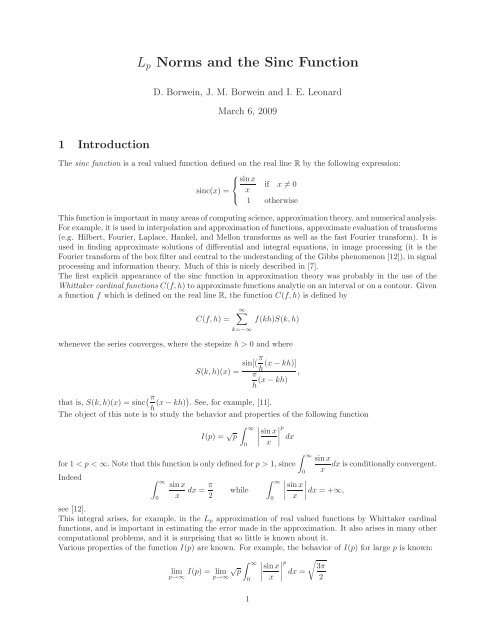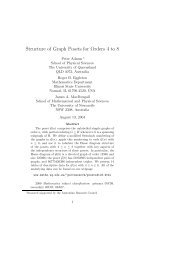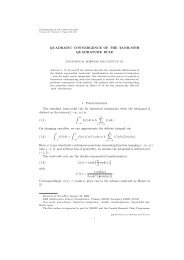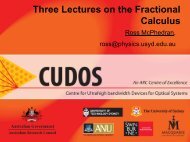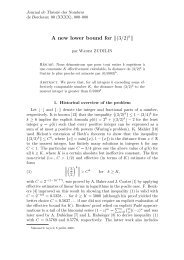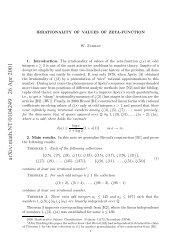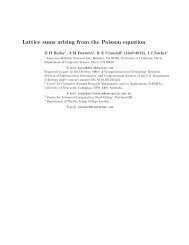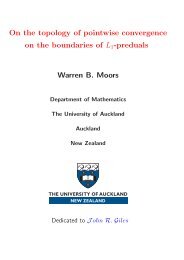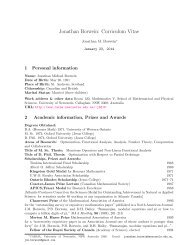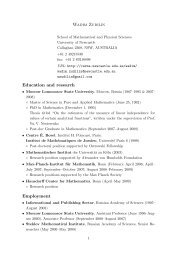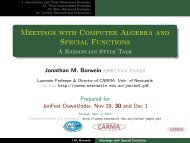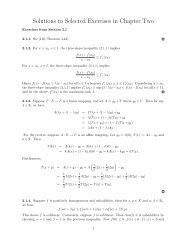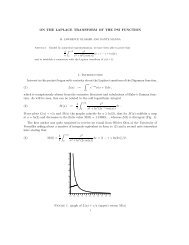Lp Norms and the Sinc Function - Faculty of Computer Science ...
Lp Norms and the Sinc Function - Faculty of Computer Science ...
Lp Norms and the Sinc Function - Faculty of Computer Science ...
Create successful ePaper yourself
Turn your PDF publications into a flip-book with our unique Google optimized e-Paper software.
L p <strong>Norms</strong> <strong>and</strong> <strong>the</strong> <strong>Sinc</strong> <strong>Function</strong><br />
D. Borwein, J. M. Borwein <strong>and</strong> I. E. Leonard<br />
March 6, 2009<br />
1 Introduction<br />
The sinc function is a real valued function defined on <strong>the</strong> real line R by <strong>the</strong> following expression:<br />
⎧<br />
⎨sinx<br />
if x ≠ 0<br />
sinc(x) = x<br />
⎩<br />
1 o<strong>the</strong>rwise<br />
This function is important in many areas <strong>of</strong> computing science, approximation <strong>the</strong>ory, <strong>and</strong> numerical analysis.<br />
For example, it is used in interpolation <strong>and</strong> approximation <strong>of</strong> functions, approximate evaluation <strong>of</strong> transforms<br />
(e.g. Hilbert, Fourier, Laplace, Hankel, <strong>and</strong> Mellon transforms as well as <strong>the</strong> fast Fourier transform). It is<br />
used in finding approximate solutions <strong>of</strong> differential <strong>and</strong> integral equations, in image processing (it is <strong>the</strong><br />
Fourier transform <strong>of</strong> <strong>the</strong> box filter <strong>and</strong> central to <strong>the</strong> underst<strong>and</strong>ing <strong>of</strong> <strong>the</strong> Gibbs phenomenon [12]), in signal<br />
processing <strong>and</strong> information <strong>the</strong>ory. Much <strong>of</strong> this is nicely described in [7].<br />
The first explicit appearance <strong>of</strong> <strong>the</strong> sinc function in approximation <strong>the</strong>ory was probably in <strong>the</strong> use <strong>of</strong> <strong>the</strong><br />
Whittaker cardinal functions C(f, h) to approximate functions analytic on an interval or on a contour. Given<br />
a function f which is defined on <strong>the</strong> real line R, <strong>the</strong> function C(f, h) is defined by<br />
C(f, h) =<br />
∞∑<br />
k=−∞<br />
f(kh)S(k, h)<br />
whenever <strong>the</strong> series converges, where <strong>the</strong> stepsize h > 0 <strong>and</strong> where<br />
S(k, h)(x) =<br />
sin[( π (x − kh)]<br />
h<br />
π<br />
h (x − kh) ,<br />
that is, S(k, h)(x) = sinc ( π<br />
h (x − kh)) . See, for example, [11].<br />
The object <strong>of</strong> this note is to study <strong>the</strong> behavior <strong>and</strong> properties <strong>of</strong> <strong>the</strong> following function<br />
I(p) = √ ∫ ∞<br />
p<br />
sin x<br />
p<br />
∣ x ∣ dx<br />
∫ ∞<br />
for 1 < p < ∞. Note that this function is only defined for p > 1, since<br />
Indeed<br />
∫ ∞<br />
0<br />
sin x<br />
x dx = π 2<br />
0<br />
while<br />
∫ ∞<br />
0<br />
0<br />
sin x<br />
∣ x ∣ dx = +∞,<br />
sin x<br />
dx is conditionally convergent.<br />
x<br />
see [12].<br />
This integral arises, for example, in <strong>the</strong> L p approximation <strong>of</strong> real valued functions by Whittaker cardinal<br />
functions, <strong>and</strong> is important in estimating <strong>the</strong> error made in <strong>the</strong> approximation. It also arises in many o<strong>the</strong>r<br />
computational problems, <strong>and</strong> it is surprising that so little is known about it.<br />
Various properties <strong>of</strong> <strong>the</strong> function I(p) are known. For example, <strong>the</strong> behavior <strong>of</strong> I(p) for large p is known:<br />
∫<br />
√ ∞<br />
lim I(p) = lim p<br />
p→∞ p→∞<br />
0<br />
1<br />
∣<br />
sinx<br />
x<br />
√ p<br />
3π<br />
∣ dx =<br />
2
Figure 1: The function I on [2, 10]<br />
This result, obtained independently by A. Meir <strong>and</strong> I. E. Leonard, is in principle not new (see equation 3).<br />
We provide a self-contained pro<strong>of</strong> below as part <strong>of</strong> our more general result in Theorem 1.<br />
Also, for integer p, <strong>the</strong> integral<br />
∫ ∞<br />
0 x<br />
can be calculated explicitly. In fact, for n ≥ 1 we have<br />
∫ ∞<br />
0<br />
( ) n sinx<br />
dx =<br />
x<br />
1<br />
(n − 1)! ·<br />
( ) p sin x<br />
dx<br />
⌊<br />
π<br />
n 2 ⌋<br />
2 n ·<br />
∑<br />
( n<br />
(−1) k k<br />
k=0<br />
) (n<br />
− 2k<br />
) n−1<br />
This result is most definitely not new, it can be found in Bromwich [4, Exercise 22, p. 518], where it is<br />
attributed to Wolstenholme, <strong>and</strong> in many o<strong>the</strong>r places—including two relatively recent articles on integrals<br />
<strong>of</strong> more general products <strong>of</strong> sinc functions [2, 3].<br />
Thus, if p is an even integer, <strong>the</strong>n we have a closed form expression for I(p), <strong>and</strong> in this case <strong>the</strong> values <strong>of</strong><br />
I(p) can be calculated exactly:<br />
I(p) = √ p<br />
∫ ∞<br />
0<br />
( ) p sin x<br />
dx = √ 1<br />
p ·<br />
x (p − 1)! · π<br />
⌊ p 2 ⌋<br />
2 p ·<br />
∑<br />
( p (p<br />
(−1)<br />
k) k ) p−1.<br />
− 2k (1)<br />
In particular I(2) = π/ √ 2, I(4) = 2π/3 <strong>and</strong> I(6) = 11 √ 6π/40. That said, this sum is very difficult to use<br />
numerically for large p. Not only are <strong>the</strong> rational factors growing rapidly but it contains extremely large<br />
terms <strong>of</strong> alternating sign <strong>and</strong> consequently dramatic cancelations. For example<br />
I(36) = 731509401860533204925821188658871713<br />
1063081066500632194410149314560000000 π,<br />
<strong>and</strong> I(10) = Q 100 π where Q 100 is a rational number whose numerator <strong>and</strong> denominator both have roughly<br />
150 digits. Similarly I(12) = Q 144 π where Q 144 is comprised <strong>of</strong> 240 digit integers. We also note that<br />
numerical integration <strong>of</strong> I(p) even to single precision is not easy <strong>and</strong> so (1) provides a very good confirmation<br />
<strong>of</strong> numerical integration results. We challenge <strong>the</strong> reader to numerically confirm <strong>the</strong> limit at infinity to 8<br />
places.<br />
The behavior <strong>of</strong> I(p) for intermediate values <strong>of</strong> p is not fully established. It had been conjectured that I(p)<br />
had a global minimum at p = 4, however, (very) recent computations using both Maple <strong>and</strong> Ma<strong>the</strong>matica<br />
suggest that <strong>the</strong> global minimum, <strong>and</strong> unique critical point, is at approximately p = 3.36... as illustrated in<br />
Figure 1.<br />
√<br />
Although it is known that lim I(p) = +∞, <strong>and</strong> that lim I(p) = 3π<br />
p→1 + p→∞ 2<br />
, it is not known precisely how <strong>the</strong><br />
√<br />
3π<br />
2<br />
asymptote y = is approached, although both numerical <strong>and</strong> graphical evidence strongly suggest <strong>the</strong><br />
following conjecture:<br />
k=0<br />
2
Figure 2: The function I <strong>and</strong> its limiting value on [2, 100]<br />
Conjecture I is increasing for p above <strong>the</strong> conjectured global minimum near 3.36 <strong>and</strong> concave for p above<br />
an inflection point near 4.469.<br />
√<br />
3π<br />
This is shown in Figure 2 in which <strong>the</strong> dashed line has height<br />
2<br />
. Moreover, in Theorem 2 we shall prove<br />
√ √ (<br />
3π 2p 3π<br />
I(p) ><br />
2 2p + 1 > 1 − 1 )<br />
, (2)<br />
2 2p<br />
for all p > 1.<br />
We conclude this introduction by observing that one can derive <strong>the</strong> existence <strong>of</strong> an asymptotic expansion for<br />
I(p) from a general result <strong>of</strong> Olver [10] on asymptotics <strong>of</strong> integrals using critical point <strong>the</strong>ory <strong>and</strong> contour<br />
integration. Specialized to our case, [10, Theorem 7.1, p. 127] (with q = 1 <strong>and</strong> p = log(sin(x)/x) on [−π, π])<br />
establishes <strong>the</strong> existence <strong>of</strong> real constants c s such that<br />
I(p) ∼ 1 ∫<br />
√ π<br />
p 2 ∣<br />
∼<br />
sin(x)<br />
−π x<br />
√<br />
3π<br />
2 − 3<br />
√<br />
3π<br />
20 2<br />
∣<br />
p<br />
dx<br />
1<br />
∞ p + ∑<br />
s=2<br />
c s<br />
1<br />
p s + · · · (3)<br />
as p → ∞. From this one may deduce that I(p) is concave <strong>and</strong> increasing for sufficiently large values <strong>of</strong><br />
p—consistent with our stronger conjecture—as (3) may be differentiated termwise.<br />
2 Our Main Results<br />
In order to study <strong>the</strong> properties <strong>of</strong> <strong>the</strong> function I(p), we consider first <strong>the</strong> functions<br />
∫ ∞<br />
(<br />
ϕ n (p) = log<br />
sinx<br />
n ∣<br />
∣ x ∣)<br />
·<br />
sin x<br />
p<br />
∣ x ∣ dx<br />
for p > 1 <strong>and</strong> n a nonnegative integer. We write<br />
0<br />
ϕ(p) = ϕ 0 (p) =<br />
∫ ∞<br />
0<br />
sin x<br />
∣ x ∣<br />
In Lemma 1 below we confirm that ϕ(p) is analytic in a region containing (1, ∞) <strong>and</strong> that its n-th derivative<br />
for p > 1 is given by ϕ (n) (p) = ϕ n (p).<br />
Then in Theorem 1 we shall use induction to prove <strong>the</strong> following result for n a nonnegative integer:<br />
√<br />
3<br />
lim<br />
p→∞ pn+1 2 ϕ (n) (p) = (−1)<br />
(n n<br />
2 Γ + 1 )<br />
.<br />
2<br />
p<br />
dx.<br />
3
The base case, n = 0, for our induction is established in Lemma 2 below. It uses Laplace’s method for<br />
determining asymptotic behavior <strong>of</strong> an integral for large values <strong>of</strong> a parameter p, see, e.g., [6, p. 60].<br />
Lemma 1 For p − 1 > z > 1 − p,<br />
∞∑<br />
ϕ(p − z) = (−1) n ϕ n (p) zn<br />
n! .<br />
n=0<br />
In particular, ϕ(p) is analytic in a region containing (1, ∞) <strong>and</strong> its n-th derivative for p > 1 is given by<br />
ϕ (n) (p) = ϕ n (p).<br />
Pro<strong>of</strong>. We have<br />
ϕ(p − z) =<br />
=<br />
sin x<br />
p−z ∫ ∞ ∞∑<br />
(<br />
∣<br />
0 x ∣ dx = dx − log<br />
sin x<br />
n ∣<br />
∣<br />
0<br />
x ∣)<br />
·<br />
sin x<br />
p z n<br />
∣ x ∣<br />
(4)<br />
n!<br />
n=0<br />
∞∑<br />
∫ ∞<br />
(<br />
− log<br />
sin x<br />
n ∣<br />
∣ x ∣)<br />
·<br />
sinx<br />
p z n ∞<br />
∣ x ∣ n! dx = ∑<br />
(−1) n ϕ n (p) zn<br />
n! , (5)<br />
∫ ∞<br />
n=0<br />
0<br />
n=0<br />
<strong>the</strong> inversion <strong>of</strong> sum <strong>and</strong> integral in (4) being justified as follows:<br />
Case i. p − 1 > z ≥ 0. All <strong>the</strong> terms involved are nonnegative.<br />
Case ii. 0 > z > 1 − p. By Case i<br />
ϕ(p − |z|) =<br />
∫ ∞<br />
0<br />
∞∑<br />
(<br />
dx − log<br />
sin x<br />
n ∣<br />
∣ x ∣)<br />
·<br />
sin x<br />
p |z| n<br />
∣ x ∣ n!<br />
n=0<br />
< ∞.<br />
Thus (5) yields <strong>the</strong> Taylor series for ϕ(p − z) at z = 0, <strong>and</strong> <strong>the</strong> final conclusion follows.<br />
Lemma 2<br />
Pro<strong>of</strong>. Let a > 0, <strong>the</strong>n for p > 1 we have<br />
I(p) = √ ∫ ∞<br />
p<br />
p<br />
sin x<br />
∣ x ∣ dx = √ p<br />
We show first that<br />
0<br />
√<br />
√ 3π<br />
lim I(p) = lim pϕ(p) =<br />
p→∞ p→∞ 2 . (6)<br />
lim<br />
p→∞<br />
∫ a<br />
0<br />
∫<br />
√ ∞<br />
p ∣<br />
a<br />
p<br />
sin x<br />
∣ x ∣ dx + √ p<br />
sinx<br />
x<br />
It suffices to consider <strong>the</strong> case 0 < a < 1; since for a ≥ 1, we have<br />
∫<br />
√ ∞<br />
p ∫ p sin x<br />
√ b<br />
∣<br />
a x ∣ dx ≤ lim p<br />
b→∞ a<br />
as p → ∞.<br />
Now, for a < x < 1, we have<br />
<strong>and</strong> it follows that<br />
0 < √ p<br />
∫ ∞<br />
a<br />
0 < sinx<br />
x<br />
< sina<br />
a<br />
∫ ∞<br />
a<br />
p<br />
sin x<br />
∣ x ∣ dx.<br />
p<br />
∣ dx = 0. (7)<br />
√<br />
1 p<br />
x p dx = p − 1 ·<br />
< 1,<br />
sin x<br />
p<br />
∣ x ∣ dx ≤ √ ∫ 1<br />
p<br />
sin x<br />
p<br />
∣<br />
a x ∣ dx + √ p<br />
≤ (1 − a) √ p<br />
sin a<br />
p<br />
∣ a ∣ +<br />
1<br />
−→ 0<br />
ap−1 ∫ ∞<br />
1<br />
∣<br />
sin x<br />
x<br />
√ p<br />
p − 1 −→ 0<br />
p<br />
∣ dx<br />
4
as p → ∞. This establishes (7).<br />
We next use <strong>the</strong> following easily proved results [9, 8]:<br />
1 − x2<br />
6 ≤ sin x<br />
x<br />
≤ 1 − x2<br />
6 + x4<br />
120<br />
for all real x, (8)<br />
<strong>and</strong> ∫ 1<br />
√ π<br />
(1 − u 2 ) p Γ(p + 1)<br />
du =<br />
0<br />
2 Γ ( ).<br />
p + 3 (9)<br />
2<br />
where <strong>the</strong> equality is a special case <strong>of</strong> a beta-function evaluation (see also [12, Theorem 7.69]). It follows<br />
from (8) <strong>and</strong> (9) that<br />
∫ √ 6<br />
0<br />
p<br />
sinx<br />
∣ x ∣ dx ≥ √ 6<br />
∫ 1<br />
0<br />
√<br />
3π<br />
(1 − u 2 ) p du =<br />
2<br />
Γ(p + 1)<br />
Γ ( ),<br />
p + 3 (10)<br />
2<br />
<strong>and</strong> hence that<br />
liminf<br />
p→∞<br />
3π<br />
I(p) ≥ lim<br />
p→∞√<br />
2<br />
√ p Γ(p + 1)<br />
Γ ( )<br />
p + 3 . (11)<br />
2<br />
Now, in order to get an appropriate inequality for <strong>the</strong> limsup, we note that for any w > 1 such that<br />
W = 2 √ √ (<br />
5 1 −<br />
w)<br />
1 ≤ √ 6,<br />
we have<br />
whence<br />
∫ W<br />
0<br />
sinx<br />
∣ x ∣<br />
p<br />
sinx<br />
x<br />
≤ 1 − x2<br />
6w<br />
dx ≤ √ ∫ √6w W<br />
6w (1 − u 2 ) p du ≤ √ 6w<br />
0<br />
for 0 < x < W, (12)<br />
∫ 1<br />
0<br />
√<br />
3πw<br />
(1 − u 2 ) p Γ(p + 1)<br />
du =<br />
2 Γ ( ).<br />
p + 3 (13)<br />
2<br />
It follows from (7) <strong>and</strong> (13) that<br />
<strong>and</strong> <strong>the</strong>refore from (11) <strong>and</strong> (14), for w > 1 we have<br />
lim<br />
p→∞<br />
√<br />
3π<br />
2<br />
√ √ 3πw p Γ(p + 1)<br />
limsup I(p) ≤ lim<br />
p→∞ p→∞ 2 Γ ( )<br />
p + 3 , (14)<br />
2<br />
√ p Γ(p + 1)<br />
Γ ( )<br />
p + 3 ≤ liminf I(p) ≤ limsup<br />
p→∞<br />
2<br />
p→∞<br />
Letting p → ∞ in (15), since for any a > 0, we have<br />
lim<br />
a→∞<br />
from [8, Problem 2, p. 45] or (23), we obtain<br />
√<br />
3π<br />
2 ≤ liminf<br />
p→∞<br />
√ (<br />
a Γ a +<br />
1<br />
2<br />
Γ(a + 1)<br />
)<br />
I(p) ≤ lim<br />
p→∞<br />
= 1,<br />
I(p) ≤ limsup I(p) ≤<br />
p→∞<br />
for all w > 1. Finally, letting w → 1 + , we get <strong>the</strong> desired equation (6).<br />
We are now ready for our more general result.<br />
√ √ 3πw p Γ(p + 1)<br />
2 Γ ( )<br />
p + 3 . (15)<br />
2<br />
√<br />
3πw<br />
2 , (16)<br />
5
Theorem 1 For all natural numbers n we have<br />
lim<br />
p→∞ pn+1 2 ϕ (n) (p) =<br />
lim<br />
p→∞ pn+1 2<br />
∫ ∞<br />
0<br />
(<br />
log<br />
∣<br />
= (−1) n √<br />
3<br />
2 Γ (<br />
n + 1 2<br />
sinx<br />
n p<br />
∣<br />
x ∣)<br />
·<br />
sin x<br />
∣ x ∣ dx<br />
)<br />
. (17)<br />
Pro<strong>of</strong>. The first equality was noted above. We proceed to establish equation (17) by induction. The pro<strong>of</strong><br />
<strong>of</strong> <strong>the</strong> base case was given in Lemma 1.<br />
For <strong>the</strong> inductive step <strong>of</strong> <strong>the</strong> pro<strong>of</strong>, we assume that for a given nonnegative integer n, we have<br />
√<br />
3<br />
lim<br />
p→∞ pn+1 2 ϕ (n) (p) = (−1)<br />
(n n<br />
2 Γ + 1 )<br />
.<br />
2<br />
It is easily verified that x < − log(1 − x) <<br />
x<br />
∣ ∣∣∣<br />
1 − x for 0 < x < 1, <strong>and</strong> setting x = 1 − sint<br />
p<br />
t ∣ , that<br />
1 −<br />
sin t<br />
p<br />
∣ t ∣ < − log<br />
sint<br />
p 1 −<br />
sin t<br />
p<br />
∣<br />
t ∣<br />
∣ t ∣ <<br />
sin t<br />
p<br />
∣ t ∣<br />
for all but countably many values <strong>of</strong> t.<br />
For q > p + 1, multiplying <strong>the</strong>se inequalities by <strong>the</strong> nonnegative term<br />
(−1)<br />
(log<br />
n sint<br />
n ∣<br />
∣ t ∣)<br />
·<br />
sin t<br />
q<br />
∣ t ∣ ,<br />
we have<br />
) ( 0 ≤ (−1)<br />
(log<br />
n sin t<br />
n ∣∣∣∣ sin t<br />
∣ t ∣ t ∣<br />
q<br />
−<br />
sin t<br />
∣ t<br />
) (<br />
∣<br />
∣p+q<br />
< −(−1) n p log<br />
∣<br />
sin t<br />
t<br />
n+1 ∣<br />
∣)<br />
·<br />
∣<br />
) ( < (−1)<br />
(log<br />
n sin t<br />
n ∣∣∣∣ sin t<br />
∣ t ∣ t ∣<br />
sin t<br />
t<br />
q−p<br />
∣<br />
q<br />
−<br />
sint<br />
∣ t ∣<br />
for <strong>the</strong> same values <strong>of</strong> t, <strong>and</strong> integrating over (0, ∞) yields<br />
) (<br />
)<br />
(−1)<br />
(ϕ n (n) (q) − ϕ (n) (p + q) ≤ −(−1) n p ϕ (n+1) (q) ≤ (−1) n ϕ (n) (q − p) − ϕ (n) (q) ,<br />
q )<br />
<strong>and</strong> hence<br />
(−1) n ⎛<br />
⎝ qn+1 2 ϕ (n) (q)<br />
p q n+1 2<br />
⎞<br />
− (p + q)n+1 2 ϕ (n) (p + q)<br />
⎠ ≤ −(−1) n qn+1+1 2 ϕ (n+1) (q)<br />
p (p + q) n+1 2<br />
q n+1+1 2<br />
≤ (−1) n ⎛<br />
⎝ (q − p)n+1 2 ϕ (n) (q − p)<br />
p (q − p) n+1 2<br />
⎞<br />
− qn+1 2 ϕ (n) (q)<br />
⎠. (18)<br />
p q n+1 2<br />
Now let q = kp, where k > 2 is fixed, <strong>the</strong>n (18) becomes<br />
⎛<br />
⎞<br />
(−1) n ⎝k q n+1 2 ϕ (n) (q) − k (p + q)n+1 2 ϕ (n) (p + q)<br />
⎠ ≤<br />
(1 + 1 k )n+1 2<br />
≤<br />
−(−1) n q n+1+1 2 ϕ (n+1) (q)<br />
(−1) n ⎛<br />
⎝k (q − p)n+1 2 ϕ (n) (q − p)<br />
(1 − 1 k )n+1 2<br />
⎞<br />
− k q n+1 2 ϕ (n) (q) ⎠ .<br />
6
Next let q → ∞, keeping k > 2 fixed, so that p → ∞ <strong>and</strong> q −p = (k −1)p → ∞. It follows from <strong>the</strong> inductive<br />
hypo<strong>the</strong>sis that<br />
√<br />
3<br />
lim<br />
q→∞ qn+1 2 ϕ (n) (q) = lim (p +<br />
q→∞ q)n+1 2 ϕ (n) (p + q) = lim (q −<br />
q→∞ p)n+1 2 ϕ (n) (q − p) = (−1)<br />
(n n<br />
2 Γ + 1 )<br />
,<br />
2<br />
<strong>and</strong> <strong>the</strong>refore<br />
⎛<br />
k<br />
⎝k −<br />
(<br />
1 +<br />
1<br />
k<br />
<strong>Sinc</strong>e<br />
lim<br />
k→∞<br />
) n+<br />
1<br />
2<br />
⎛<br />
⎞<br />
⎠<br />
⎝k −<br />
√ ( 3<br />
2 Γ n + 1 )<br />
2<br />
k<br />
(<br />
1 +<br />
1<br />
k<br />
) n+<br />
1<br />
2<br />
⎞<br />
≤<br />
≤<br />
⎠ = lim<br />
liminf<br />
q→∞<br />
⎛<br />
⎝<br />
k→∞<br />
(−1)n+1 q n+1+1 2 ϕ (n+1) (q) ≤ limsup (−1) n+1 q n+1+1 2 ϕ (n+1) (q)<br />
q→∞<br />
k<br />
(<br />
1 −<br />
1<br />
k<br />
⎛<br />
⎝<br />
) n+<br />
1<br />
2<br />
k<br />
(<br />
1 −<br />
1<br />
k<br />
) n+<br />
1<br />
2<br />
⎞<br />
− k⎠<br />
√ ( 3<br />
2 Γ n + 1 )<br />
. (19)<br />
2<br />
⎞<br />
− k⎠ 1 − (1 + t) −n−1 2<br />
= lim<br />
= n + 1<br />
t→0 t<br />
2 ,<br />
it follows from (19) that<br />
√ ( 3<br />
lim<br />
q→∞ (−1)n+1 q n+1+1 2 ϕ (n+1) (q) = n + 1 ) (<br />
Γ n + 1 ) √ ( 3<br />
=<br />
2 2 2 2 Γ n + 1 + 1 )<br />
,<br />
2<br />
<strong>and</strong> this completes <strong>the</strong> pro<strong>of</strong> <strong>of</strong> <strong>the</strong> inductive step.<br />
3 Final Remarks<br />
Our pro<strong>of</strong> <strong>of</strong> Theorem 1 shows both that<br />
lim<br />
p→∞ pn+1 2 ϕ (n) (p) = a n (20)<br />
exists <strong>and</strong> determines <strong>the</strong> value <strong>of</strong> a n . If we know in advance that <strong>the</strong> limit exists for every nonnegative<br />
integer n, <strong>the</strong>n we can use Lemmas 1 <strong>and</strong> 2 to write<br />
√<br />
lim p ϕ(p(1 + x)) = lim<br />
p→∞<br />
p→∞<br />
∞∑<br />
n=0<br />
p n+1 2 ϕ (n) (p) xn<br />
n! = √<br />
3π/2<br />
√ 1 + x<br />
for 1 − 1 p > x > 1 p<br />
− 1, <strong>and</strong> <strong>the</strong>n justify <strong>the</strong> exchange <strong>of</strong> limit <strong>and</strong> sum, <strong>and</strong> exp<strong>and</strong> <strong>the</strong> final term to obtain<br />
∞∑<br />
n=0<br />
a n<br />
x n<br />
n! = ∞<br />
∑<br />
n=0<br />
√<br />
3<br />
2 (−1)n Γ ( n + 1 2<br />
) x n<br />
n! .<br />
Comparing coefficients <strong>of</strong> <strong>the</strong> above two exponential generating functions yields <strong>the</strong> desired valuation<br />
a n =<br />
√<br />
3<br />
2 (−1)n Γ ( n + 1 2)<br />
. (21)<br />
In fact, to justify <strong>the</strong> exchange by means <strong>of</strong> <strong>the</strong> series version <strong>of</strong> Lebesgue’s <strong>the</strong>orem on dominated convergence<br />
one needs to establish something like ∣ ∣∣∣∣∣<br />
p n+1 2 ϕ (n) (p)<br />
n!<br />
∣ ≤ M<br />
with M a positive constant independent <strong>of</strong> n <strong>and</strong> p, <strong>and</strong> this requires an inequality such as <strong>the</strong> right-h<strong>and</strong><br />
side <strong>of</strong> (19) (with q replaced by p <strong>and</strong> n by n − 1) used in <strong>the</strong> given pro<strong>of</strong> <strong>of</strong> Theorem 1.<br />
7
Ano<strong>the</strong>r way <strong>of</strong> determining <strong>the</strong> value <strong>of</strong> a n in (20) if we know it exists for every n, is to proceed via<br />
L’Hospital’s rule as follows:<br />
ϕ (n−1) (p)<br />
a n−1 = lim = lim<br />
p→∞<br />
p −n+1 p→∞<br />
2<br />
ϕ (n) (p)<br />
−(n − 1 2 )p−n−1 2<br />
= − a n<br />
n − 1 ,<br />
2<br />
whence, by Lemma 2,<br />
which is (20) again.<br />
a n = (−1) n a 0 n ∏<br />
k=1<br />
(<br />
k − 1 ) √<br />
3<br />
=<br />
2 2 (−1)n Γ ( )<br />
n + 1 2<br />
One advantage <strong>of</strong> our explicit pro<strong>of</strong> <strong>of</strong> Lemma 2 over Olver’s asymptotic result in (3) is that it is easily<br />
exploited to establish (2).<br />
Theorem 2 For all p > 1 we have<br />
√<br />
3π<br />
I(p) ><br />
2<br />
2p<br />
2p + 1 > √<br />
3π<br />
2<br />
(<br />
1 − 1 )<br />
. (22)<br />
2p<br />
Pro<strong>of</strong>. For x > 0 <strong>and</strong> 0 < s < 1, Abromowitz <strong>and</strong> Stegun [1] records (as (5.6.4) in <strong>the</strong> new web version)<br />
that<br />
x 1−s Γ(x + 1)<br />
<<br />
Γ(x + s) < (x + 1)1−s . (23)<br />
Hence, from (10) <strong>and</strong> (23) we obtain for p > 1 that<br />
I(p)<br />
> √ √ √<br />
3π Γ(p + 1) 3π<br />
p<br />
2 Γ ( )<br />
p + 3 =<br />
2<br />
2<br />
√ √<br />
3π 2p 3π<br />
><br />
2 2p + 1 > 2<br />
(<br />
1 − 1<br />
2p<br />
√ p Γ(p + 1)<br />
2p + 1 Γ ( )<br />
p + 1 2<br />
)<br />
.<br />
Here, for <strong>the</strong> penultimate inequality, we have used <strong>the</strong> left-h<strong>and</strong> inequality in (23) with x = p, s = 1/2.<br />
Note that (22) implies that<br />
‖sinc‖ p ><br />
( √ ) 1/p 2 6p π<br />
2p + 1<br />
when sinc is viewed as a function in L p ([−∞, ∞]). We finish by observing that <strong>the</strong> lower bound is asymptotically<br />
<strong>of</strong> <strong>the</strong> correct order, <strong>and</strong> leave as an open question whe<strong>the</strong>r similar explicit techniques to those in<br />
Theorem 1 can be used to establish <strong>the</strong> second-order term in <strong>the</strong> asymptotic expansion (3) or <strong>the</strong> concavity<br />
properties conjectured in <strong>the</strong> introduction.<br />
References<br />
[1] M. Abramowitz <strong>and</strong> I.A. Stegun, H<strong>and</strong>book <strong>of</strong> Ma<strong>the</strong>matical <strong>Function</strong>s, NBS (now NIST), 1965. See also<br />
http://dlmf.nist.gov/.<br />
[2] D. Borwein <strong>and</strong> J. M. Borwein, “Some remarkable properties <strong>of</strong> sinc <strong>and</strong> related integrals,” Ramanujan J., 5<br />
(2001), 73–90.<br />
[3] D. Borwein, J. M. Borwein, <strong>and</strong> B. Mares, “Multi-variable sinc integrals <strong>and</strong> volumes <strong>of</strong> polyhedra,”<br />
Ramanujan J., 6 (2002), 189–208.<br />
[4] T. J. Bromwich, Theory <strong>of</strong> Infinite Series, First Edition 1908, Second Edition 1926, Blackie & Sons, Glasgow.<br />
[5] H. S. Carslaw, An Introduction to <strong>the</strong> Theory <strong>of</strong> Fourier’s Series <strong>and</strong> Integrals, Third Revised Edition, Dover<br />
Publications Inc., New Jersey, 1950.<br />
[6] N. G. de Bruijn, Asymptotic Methods in Analysis, Second Edition, North-Holl<strong>and</strong> Publishing Co., Amsterdam,<br />
1961.<br />
8
[7] W. B. Gearhart <strong>and</strong> H. S. Schultz, “The function sin(x)<br />
x<br />
,” The College Ma<strong>the</strong>matics Journal, 2 (1990), 90–99.<br />
[8] P. Henrici, Applied <strong>and</strong> Computational Complex Analysis Volume 2, John Wiley & Sons, Inc., New York, 1977.<br />
[9] I. E. Leonard <strong>and</strong> James Duemmel, “More–<strong>and</strong> Moore–Power Series without Taylor’s Theorem,” The<br />
American Ma<strong>the</strong>matical Monthly, 92 (1985), 588–589.<br />
[10] F. W. J. Olver, Asymptotics <strong>and</strong> Special <strong>Function</strong>s (AKP Classics), Second Edition, AK Peters, Nattick, Mass,<br />
1997.<br />
[11] F. Stenger, Numerical Methods Based on <strong>Sinc</strong> <strong>and</strong> Analytic <strong>Function</strong>s, Springer Series in Computational<br />
Ma<strong>the</strong>matics 20, Springer–Verlag, New York, 1993.<br />
[12] K. R. Stromberg, An Introduction to Classical Real Analysis, Wadsworth, Belmont, CA, 1981.<br />
Acknowledgements We wish to thank Amram Meir <strong>and</strong> David Bailey for very useful discussions during<br />
<strong>the</strong> preparation <strong>of</strong> this note.<br />
9
David Borwein obtained two B.Sc. degrees from Witwatersr<strong>and</strong> University, one in engineering in 1945<br />
<strong>and</strong> <strong>the</strong> o<strong>the</strong>r in ma<strong>the</strong>matics in 1948. From University College London (UK) he received a Ph.D. in 1950<br />
<strong>and</strong> a D.Sc. in 1960. He has been at <strong>the</strong> University <strong>of</strong> Western Ontario since 1963 with an emeritus title<br />
since 1989. His main area <strong>of</strong> research has been classical analysis, particularly summability <strong>the</strong>ory.<br />
Department <strong>of</strong> Ma<strong>the</strong>matics, The University <strong>of</strong> Western Ontario, London, ONT, N6A 5B7, Canada.<br />
Email: dborwein@uwo.ca<br />
Jonathan M. Borwein received his B.A. from <strong>the</strong> University <strong>of</strong> Western Ontario in 1971 <strong>and</strong> a D.Phil.<br />
from Oxford in 1974, both in ma<strong>the</strong>matics. He currently holds a Laureate Pr<strong>of</strong>essorship at University <strong>of</strong><br />
Newcastle <strong>and</strong> a Canada Research Chair in <strong>the</strong> <strong>Faculty</strong> <strong>of</strong> <strong>Computer</strong> <strong>Science</strong> at Dalhousie University. His<br />
primary current research interests are in nonlinear functional analysis, optimization, <strong>and</strong> experimental<br />
(computationally-assisted) ma<strong>the</strong>matics.<br />
School <strong>of</strong> Ma<strong>the</strong>matical <strong>and</strong> Physical <strong>Science</strong>s, University <strong>of</strong> Newcastle, Callaghan, NSW 2308, Australia<br />
<strong>and</strong> <strong>Faculty</strong> <strong>of</strong> <strong>Computer</strong> <strong>Science</strong> <strong>and</strong> Department <strong>of</strong> Ma<strong>the</strong>matics, Dalhousie University, Halifax NS, B3H<br />
2W5, Canada. Email: jonathan.borwein@newcastle.edu.au<br />
Isaac E. Leonard received his B.A. <strong>and</strong> M.A. from <strong>the</strong> University <strong>of</strong> Pennsylvania in 1961 <strong>and</strong> 1963, both<br />
in physics. He received his M.Sc. <strong>and</strong> Ph.D. from Carnegie-Mellon University in 1969 <strong>and</strong> 1973, both in<br />
ma<strong>the</strong>matics; <strong>and</strong> a B.Sc. in <strong>Computer</strong> <strong>Science</strong> from <strong>the</strong> University <strong>of</strong> Alberta in 1994. He currently holds<br />
a position as a Sessional Lecturer with <strong>the</strong> Department <strong>of</strong> Ma<strong>the</strong>matical <strong>and</strong> Statistical <strong>Science</strong>s at <strong>the</strong><br />
University <strong>of</strong> Alberta, <strong>and</strong> has taught courses in <strong>the</strong> Computing <strong>Science</strong> <strong>and</strong> Electrical <strong>and</strong> <strong>Computer</strong><br />
Engineering Departments at <strong>the</strong> University <strong>of</strong> Alberta. His current research interests are in analysis <strong>of</strong><br />
algorithms <strong>and</strong> numerical analysis.<br />
Department <strong>of</strong> Ma<strong>the</strong>matical <strong>and</strong> Statistical <strong>Science</strong>s, The University <strong>of</strong> Alberta, Edmonton, AB, T6G<br />
2G1, Canada Email: isaac@math.ualberta.ca<br />
10


